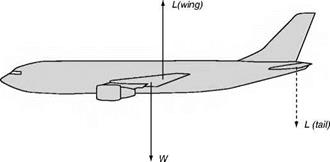Loads on tail plane
But to return to the normal aeroplane. Where the four main forces can be satisfactorily balanced in themselves, the duty of the tail plane is merely to act as a ‘stand-by’. Therefore, it will usually be set at such an angle, that at cruise speed it will be at zero angle of attack, thereby producing no lift. At flight speeds higher than the cruise speed, the lift coefficient must be lowered to compensate for the higher dynamic pressure otherwise the lift would be greater than the weight. This means that the aircraft must be trimmed a little more nose-down. In doing so, the centre of lift of the wing will move back, giving a nose-down pitching moment. However, if the angle of attack of the tail plane was zero for cruise, then it will now become negative, and the tail will generate a down-force (Fig. 5.4) producing a nose-up pitching moment which will tend to more than counteract the nose-down moment produced by the wing. In fact, as the flight speed increases, the pilot normally has to make a small nose-down trim adjustment. Correspondingly, at low speeds, the nose of the aircraft must be raised in order to increase the angle of attack. This means that the tail lift will now become positive (Fig.5.5). As the tail plane is equally likely to carry an upward or a downward force, it is usually of symmetrical camber, and therefore produces no lift at zero angle of attack. On a tail-first or canard aircraft, the foreplane is set at a slightly higher angle of attack than the wings for reasons of stability, and both wings produce lift in normal flight.
|
|
Fig 5.4 High speed: down load from tail needed to balance effect of rearward location of wing lift
|
|
Fig 5.5 Low speed: up load from tail needed to balance effect of forward location of wing lift













